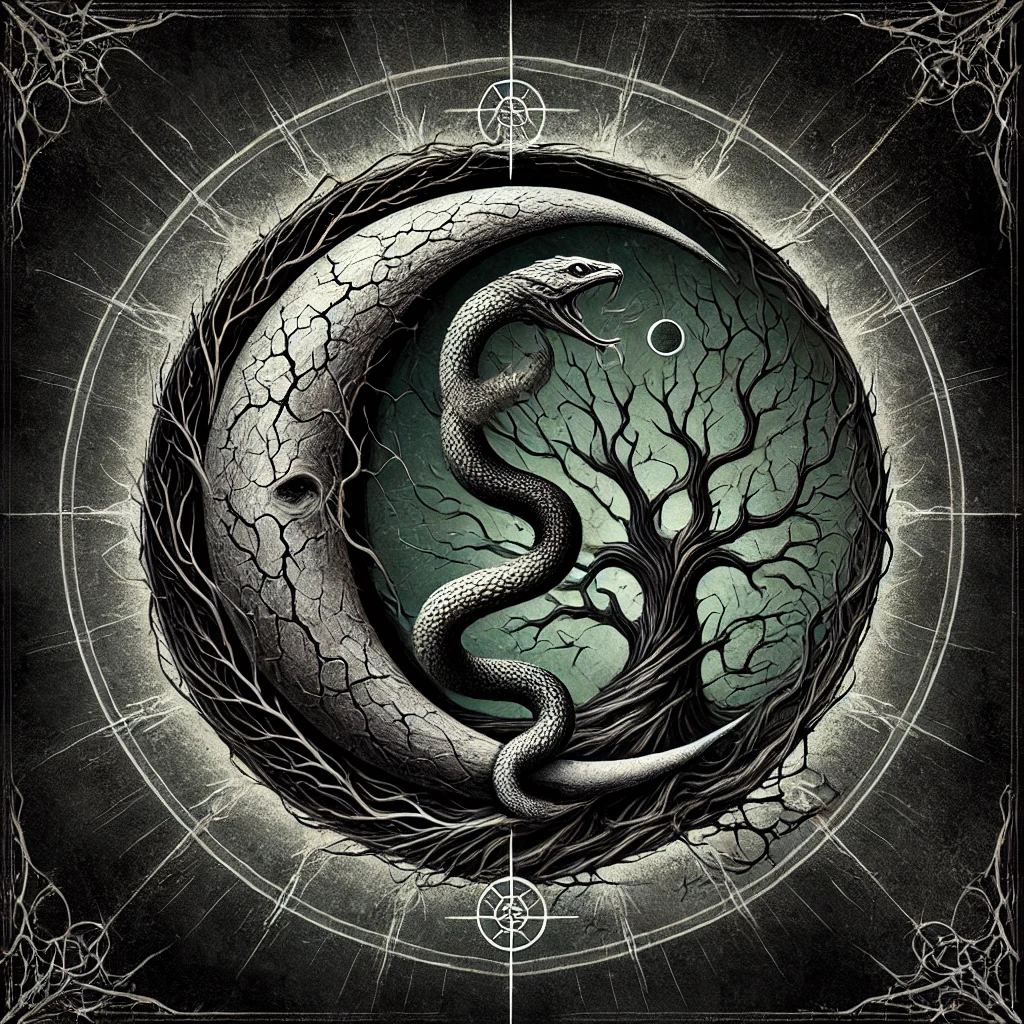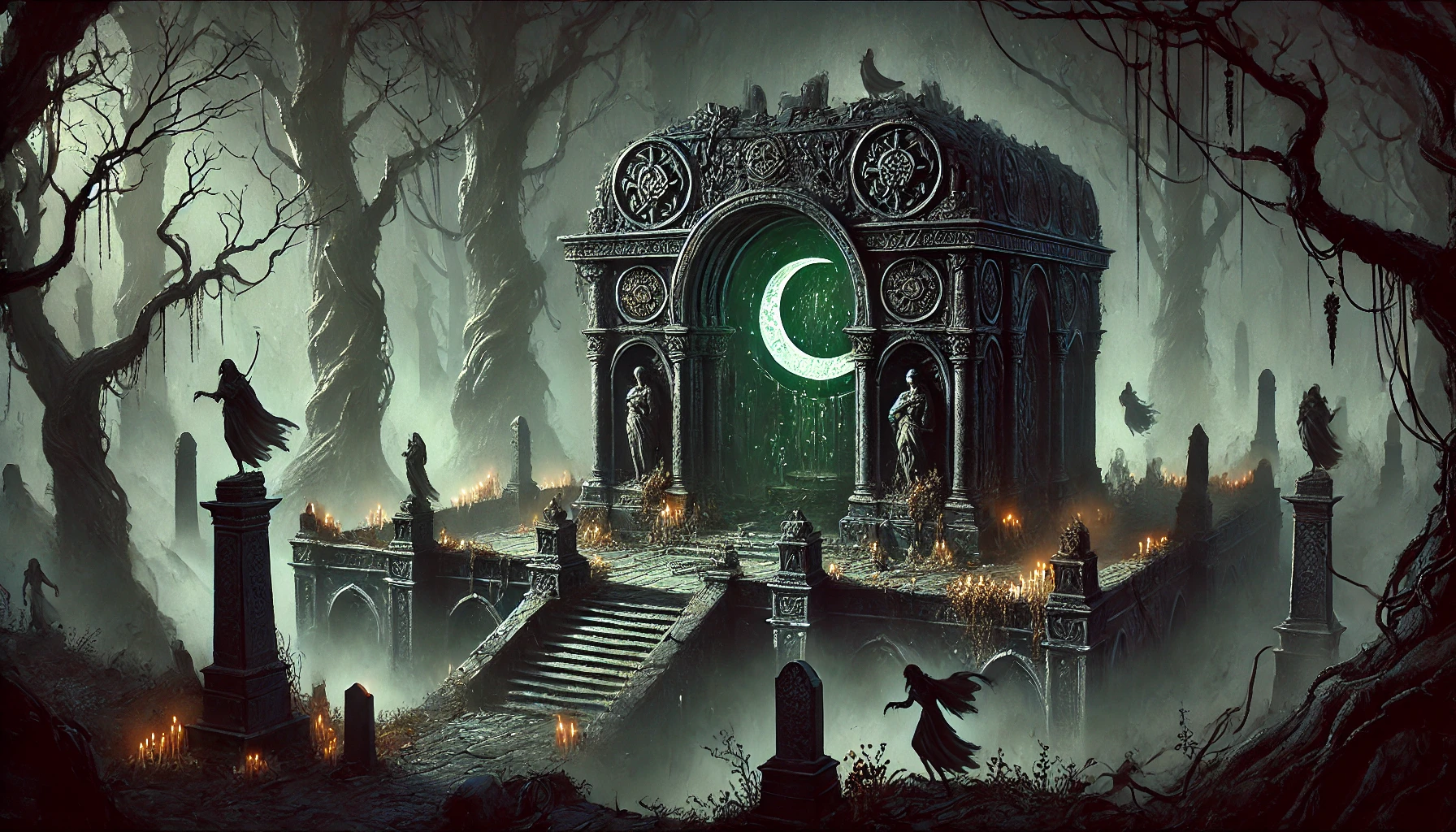Cult of the Twilit Path
The Cult of the Twilit Path is a shadowy and enigmatic religious order devoted to Daril, the god of shadow, sickness, and transformation. Founded during the Era of First Shadows, the cult embraces decay, suffering, and death as essential aspects of life's natural balance. Its followers, ranging from healers to spies and assassins, believe that resilience is forged through hardship and that only by accepting the inevitability of decay can true transformation occur.
Operating in secrecy, the cult maintains hidden Shrines of Twilight near graveyards and shadowed regions, where they perform rites of passage, tend to the dying, and safeguard sacred knowledge. While often feared for their association with darkness and entropy, the cult views itself as a necessary counterbalance to forces that unnaturally disrupt life's cycles, such as necromancy or excessive healing.
Their motto, "From Shadow, Strength," reflects their philosophy that growth arises from embracing the dark truths of existence, making them both misunderstood protectors and subtle manipulators of Dolviar's delicate balance.
Structure
- High Shadowspeaker: The leader and voice of Daril’s will.
- Shadowspeakers: Senior priests who guide spiritual and operational matters.
- Plaguebringers: Enforcers of trials through sickness and entropy.
- Deathwardens: Guardians of temples and graveyards.
- Twilight Seers: Oracles who interpret visions of shadow and decay.
- Acolytes of the Veil: Novices learning the ways of the cult.
Culture
Core Beliefs: Embrace decay, accept suffering as a teacher, and maintain the balance between life and death.
Customs: Ritual fasting, shadow dances during eclipses, and rites of passage involving endurance trials.
Symbols: Members often wear crescent moon pendants or serpent-shaped charms.
Public Agenda
Outward Message: To provide comfort to the dying, tend to graveyards, and preserve the balance between light and shadow.
Hidden Agenda: To quietly oppose forces that disrupt the natural cycle of life and death, such as necromancers or practitioners of unnatural immortality.
Assets
Sanctuaries and Shrines: Hidden temples and underground shrines across Dolviar.
Artifacts: Relics like the Shadowglass Blade and the Shroud of Twilight.
Knowledge: Forbidden texts, including the Tome of Decay and The Whispered Truths.
Trained Followers: Skilled healers, spies, and shadow mages.
History
Founding: Established during the Era of First Shadows by the First Veil to counteract unchecked growth and stagnation.
Great War of the Gods: Played a vital but hidden role, guiding those affected by the war’s devastation and ensuring the dead were honored.
Post-War Silence: Became fractured due to Daril’s silence, with factions like the Harbingers of Decay taking extreme stances.
Disbandment
N/A: The cult has not been formally disbanded, although divisions within it have created splinter factions.
Mythology & Lore
The mythology of the Cult of the Twilit Path is deeply tied to Daril’s narrative:
The First Shadows: At the dawn of creation, when light first touched the world, shadows were born. Daril emerged from these shadows, a manifestation of the in-between, tasked with guiding creation toward balance.
The Cycle of the Shattered Moon: When the green moon was shattered, the fragments fell to Dolviar, spreading entropy and transformation. The cult teaches that this event was Daril’s intervention, scattering tools to encourage change and resilience in the face of destruction.
The Harrowing of the Veils: Ancient heroes, the First Veils, were chosen by Daril to teach mortals to embrace decay. Their stories of triumph through hardship serve as parables for cult teachings.
Divine Origins
The Cult of the Twilit Path was founded during the Era of First Shadows, shortly after the world’s creation. Its teachings arose from Daril’s whispered revelations to the First Veil, a mortal prophet who endured profound suffering and emerged transformed. This prophet’s trials and visions became the basis of the cult’s sacrosanct rituals.
The cult’s rituals and teachings were further refined over centuries, with early followers developing rites to honor decay and preserve balance. Hidden shrines and sacred texts, like the Tome of Decay, ensured the teachings survived even in times of persecution.
Cosmological Views
According to the cult, the world exists in perpetual cycles of light and shadow, creation and decay:
Creation and Shadow: The world was shaped by divine hands but perfected by shadows, as Daril taught that true beauty lies in imperfection and entropy.
Life and Death as a Cycle: Death is not an end but a transformation, a return to the shadows from which all life emerged.
The Green Moon’s Remnants: The shards of the shattered moon are sacred symbols of Daril’s philosophy, representing the fragmented yet enduring nature of existence.
Tenets of Faith
Accept the Inevitable: Death and decay are natural and should be met with dignity.
Strength Through Suffering: Hardship builds resilience; avoid fleeing from pain.
Protect the Balance: Resist forces that unnaturally prolong life or bring unnecessary destruction.
Embrace Shadows: Seek hidden truths and use them to transform yourself and others.
Transformation is Renewal: Change, even through decay, is essential for growth.
Ethics
Pious Acts:
Tending to the dying with dignity.
Accepting hardship to grow stronger.
Maintaining secrecy and discretion.
Sins:
Rejecting mortality through necromancy or immortality.
Disrupting the natural cycle of life and death.
Excessive cruelty that leads to imbalance.
Worship
Rituals:
Shadow dances during eclipses.
Endurance trials as rites of passage.
Funeral rites involving the Shroud of Twilight to honor the dead.
Daily Practices:
Meditations in shadowed spaces.
Offering symbols of decay (e.g., wilted flowers) at shrines.
Priesthood
Hierarchy:
High Shadowspeaker: The ultimate leader and interpreter of Daril’s will.
Shadowspeakers: Senior priests overseeing spiritual and operational matters.
Twilight Seers: Oracles who interpret visions of shadow and decay.
Plaguebringers: Enforcers who embody trials through sickness and entropy.
Deathwardens: Guardians of shrines and graveyards.
Acolytes of the Veil: Novices in training.
Appointment: Priests are chosen through trials of endurance, suffering, and spiritual visions.
Distinctions: Priests wear shadow-hued robes with crescent pendants. Senior members may wield artifacts or bear ritual scars marking their trials.
Granted Divine Powers
Faithful Abilities
Shadow Manipulation: Level 2: This is a minor utility ability that offers flavor and limited gameplay advantage, making it suitable for early levels. As a bonus action, lightly obscure yourself or others within 5 feet for a round, granting a minor stealth bonus or disadvantage on attacks against you in dim light or darkness. 1d4
Resilience: Level 5: Enhanced endurance feels appropriate as characters start facing tougher challenges. By this point, a more robust feature will be appreciated but not overpowering. Once per long rest, gain temporary hit points equal to your level when reduced to half HP or less, or gain advantage on Constitution saving throws during a difficult situation.
Priesthood Abilities
Veil of Shadows: Level 7: Gaining near-invisibility in darkness is a significant ability and fits well as an early-mid-tier power when players face more diverse challenges and need stronger utility. As an action, become invisible in darkness for 1 minute or until you make an attack or cast a spell (usable proficiency bonus times per long rest).
Decay Aura: Level 10: Inducing decay or withering effects has a thematic tie to maturity and the growing influence of their power. At this stage, they are transitioning to facing stronger foes and encountering more nuanced challenges. As an action, create a 10-foot aura for 1 minute, forcing creatures within it to make a Constitution saving throw (DC = 8 + proficiency bonus + relevant ability modifier) or take necrotic damage and have disadvantage on Strength or Dexterity checks for 1 round. Usable once per long rest.
Prophetic Visions: Level 14: This is a significant ability, blending roleplay with mechanics. By this level, it enhances the character's narrative and can influence important moments in the campaign. Once per long rest, you can meditate or dream to receive cryptic visions of possible outcomes or future events. Mechanically, you can ask the DM for a hint about an upcoming decision, or gain advantage on an Insight or Perception check related to the vision's theme.
Political Influence & Intrigue
The cult operates in secrecy, influencing Dolviar’s political landscape through:
Advisors and Spies: Cult members serve as covert advisors, healers, and information gatherers.
Counteracting Necromancy: They oppose factions that disrupt natural cycles, such as necromancers or immortality-seekers.
Divided Loyalties: Internal factions like the Harbingers of Decay take extreme stances, occasionally clashing with the cult’s mainstream teachings, creating political rifts.
Sects
Harbingers of Decay: A radical sect advocating for accelerated decay, believing the world must be broken down to rebuild stronger.
Perception: Viewed as dangerous extremists by the mainstream cult.
Veilseekers: A secretive sect devoted to uncovering all fragments of the shattered green moon.
Perception: Respected for their dedication but sometimes criticized for prioritizing artifacts over balance.
Twilight Guardians: A militant sect focusing on defending shrines and opposing necromancers.
Perception: Revered as protectors but seen as rigid and overly combative.

"From Shadow, Strength." "Embrace the Dark to See the Light." "Decay Begets Renewal."
Approximately 5,000 years ago, during the Era of First Shadows, when Daril’s teachings first emerged in response to the unchecked growth of life without decay. - N/A: The Cult of the Twilit Path has persisted in some form across ages, adapting to changing times. Even during the gods’ silence after the Great War, the cult remained active, albeit fractured.
Remove these ads. Join the Worldbuilders Guild









Comments